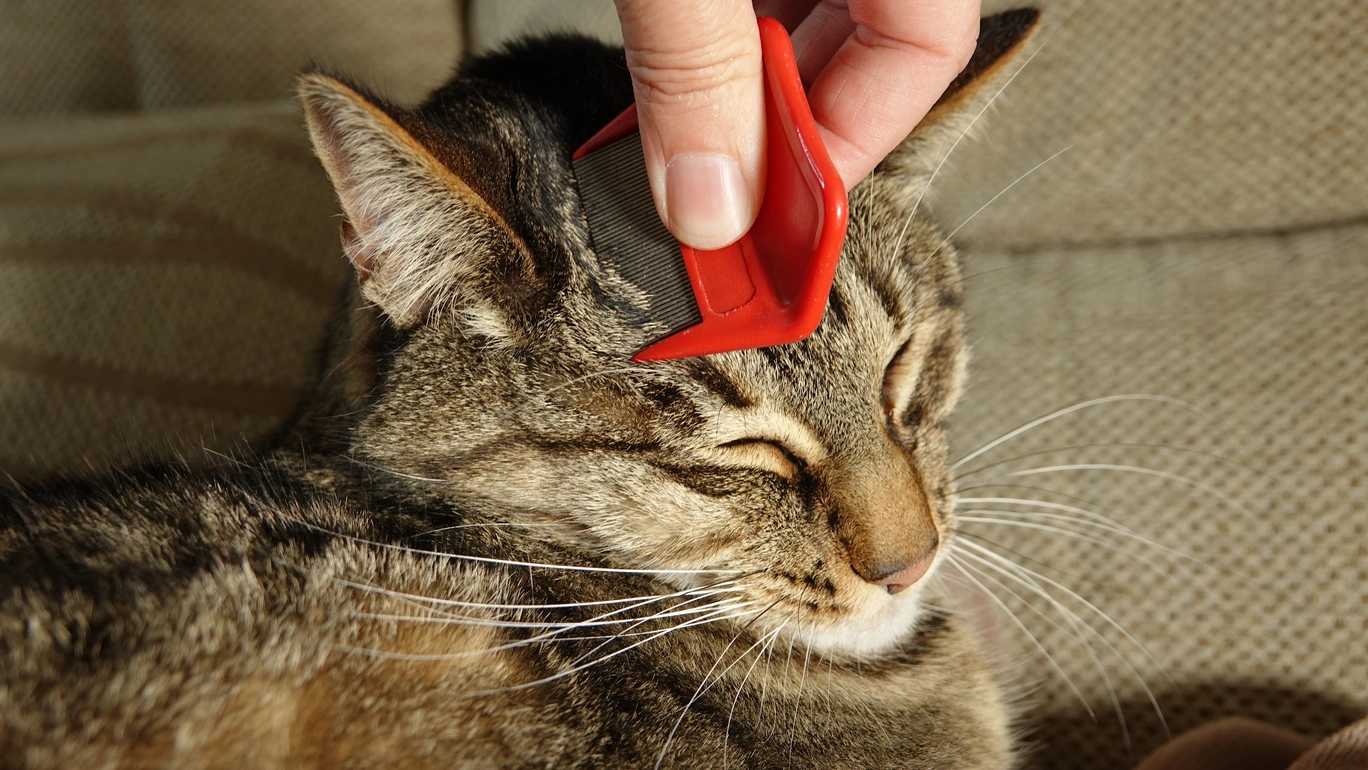1. Why Is Cat Food Important?
Cat food is the cornerstone for your cat to enjoy a long and healthy life. As of 2025, there are 3.5 million pet cats in Turkey and 78% of them are fed with commercial cat food. The right choice:
- Reduces the risk of obesity,
- Prevents kidney and urinary tract diseases,
- Supports coat and skin health,
- Minimizes behavioral problems.
Modern formulas are produced according to the FEDIAF (European Pet Food Industry Federation) guidelines of the European Union. Therefore, the balance of ingredients, calories, and minerals is far more than a random mixture.
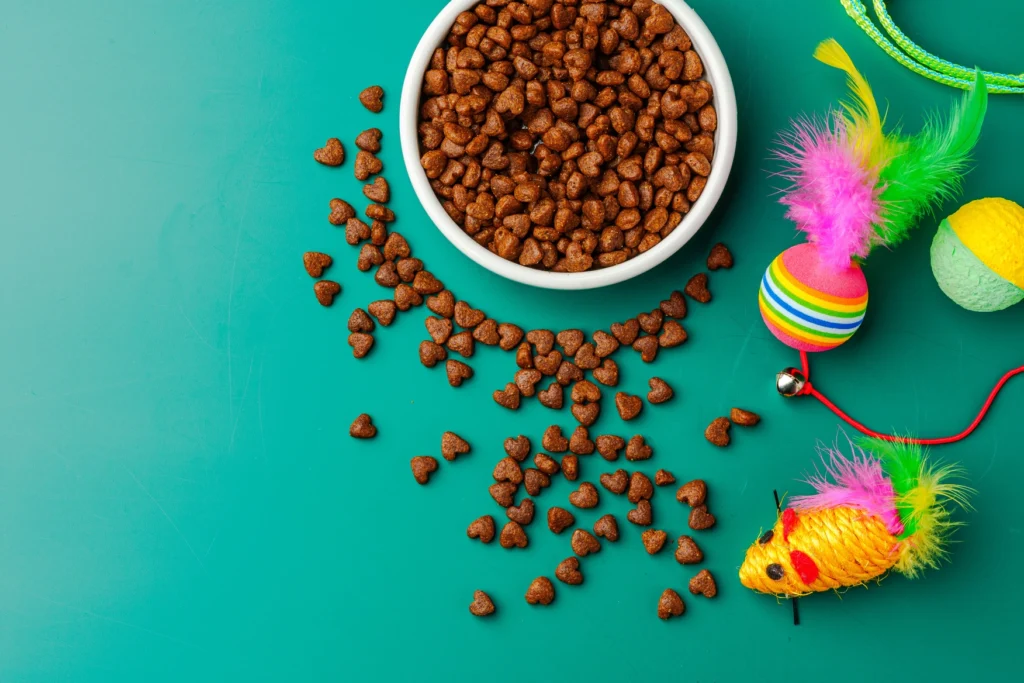
2. Types of Cat Food
2.1 Dry Cat Food
- Long shelf life and a texture that helps reduce tartar make it popular.
- Protein percentage is generally in the 30–45 range.
- Water content is <10%, so fresh water is a must.
2.2 Wet Cat Food
- Moisture content up to 70% supports kidney health.
- High palatability; a lifesaver for picky eaters.
2.3 Semi‑Moist & Pouch Foods
- Thanks to new cold‑press technology in 2025, they can be stored up to 12 months without preservatives.
2.4 Special Diet Foods
- Formulas for kidney, liver, diabetes, or allergy problems.
- May require a veterinary prescription.
Tip: Combining dry cat food for main meals with wet cat food a few times a week offers a balanced program for both dental and kidney health.
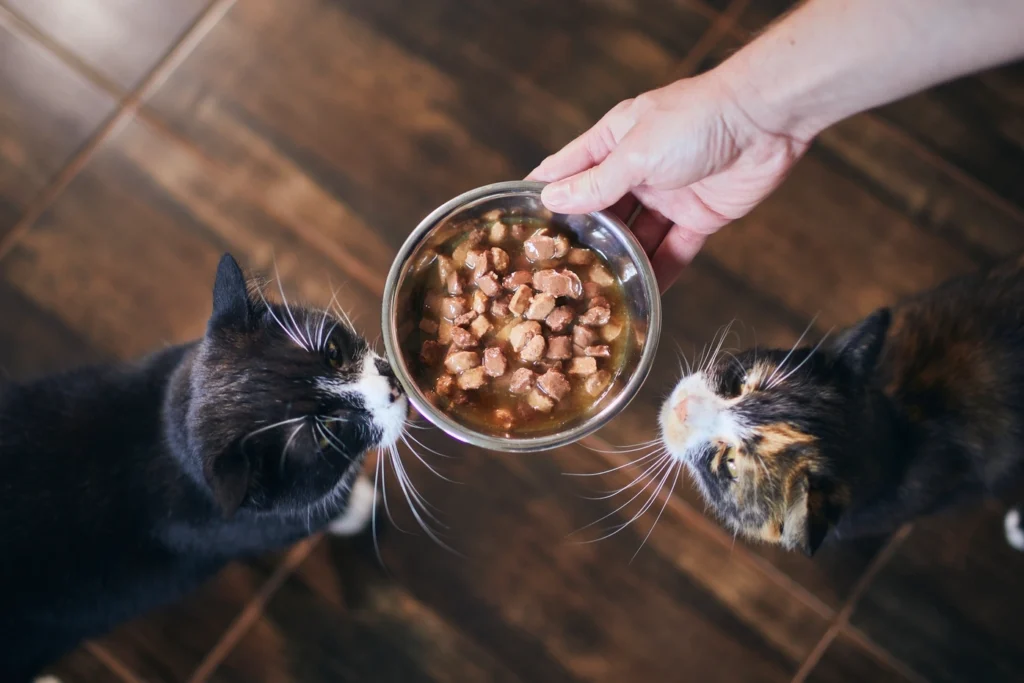
3. Label Reading 101
Technical terms on cat food packages may look complex at first glance. Here’s a quick checklist:
| Label Section | What It Means | What to Watch For |
|---|---|---|
| Analytical Constituents | Percentages of protein, fat, fiber, ash | Protein ≥ 30%, ash ≤ 8% |
| Ingredients | The first 3 items are present in the highest amounts | Animal sources like “fresh chicken,” “chicken meal” should be at the top |
| Taurine | Critical for heart & retina health | ≥ 1500 mg/kg |
| Ash | Total minerals | Excess phosphorus strains the kidneys |
| ADF & NFE | Carbohydrate measures | NFE < 25% for cats at risk of diabetes |
Alt Text Example: “percentages of protein fat fiber on a cat food label – infographic”
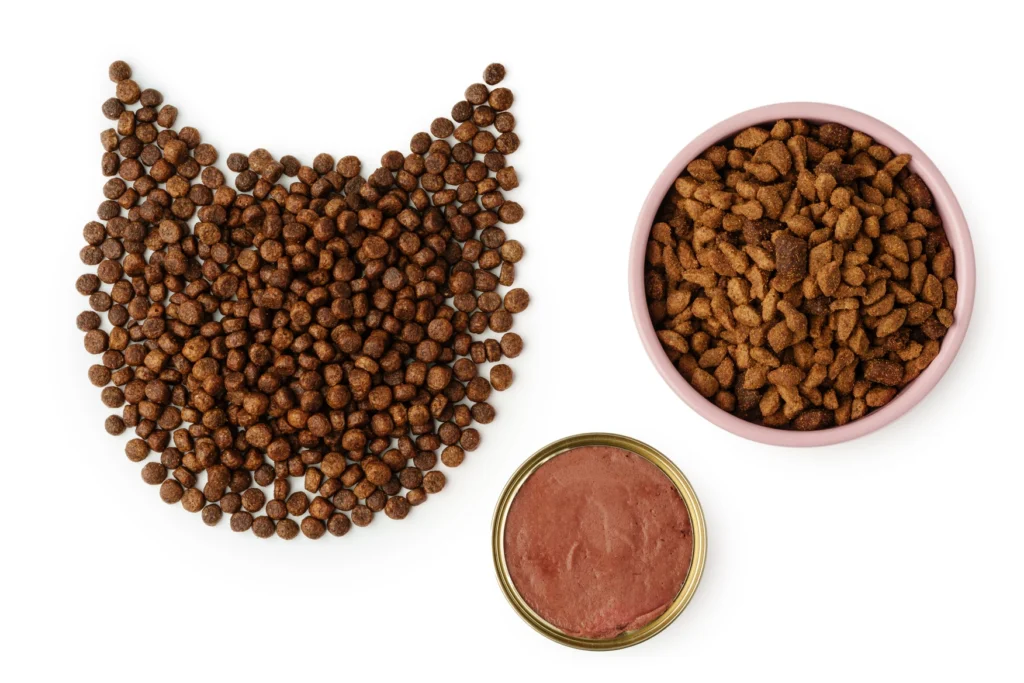
4. Feeding by Age
4.1 Kitten (0–12 Months)
- High energy: ≥ 4000 kcal/kg
- DHA‑supported brain development
4.2 Adult (1–7 Years)
- Balanced protein–fat ratio (32/16)
- Omega‑6 : Omega‑3 ≈ 5:1
4.3 Senior (7+ Years)
- Reduced phosphorus
- Added joint support (glucosamine, chondroitin)
Internal Link: Nutrition in Chronic Kidney Disease in Cats
5. Special Conditions & Diets
5.1 Allergic Cats
- Hypoallergenic foods contain a single protein source (e.g., duck).
- Hydrolyzed formulas provide up to 90% tolerance.
5.2 After Neutering/Spaying
- Energy needs drop by 20%; choose light‑label cat food.
5.3 Diabetic Feeding
- Low carbohydrate, high protein.
- Most veterinarians prefer canned foods.
5.4 Urinary Tract Health
- pH‑controlled prescriptions that prevent struvite and oxalate crystals.
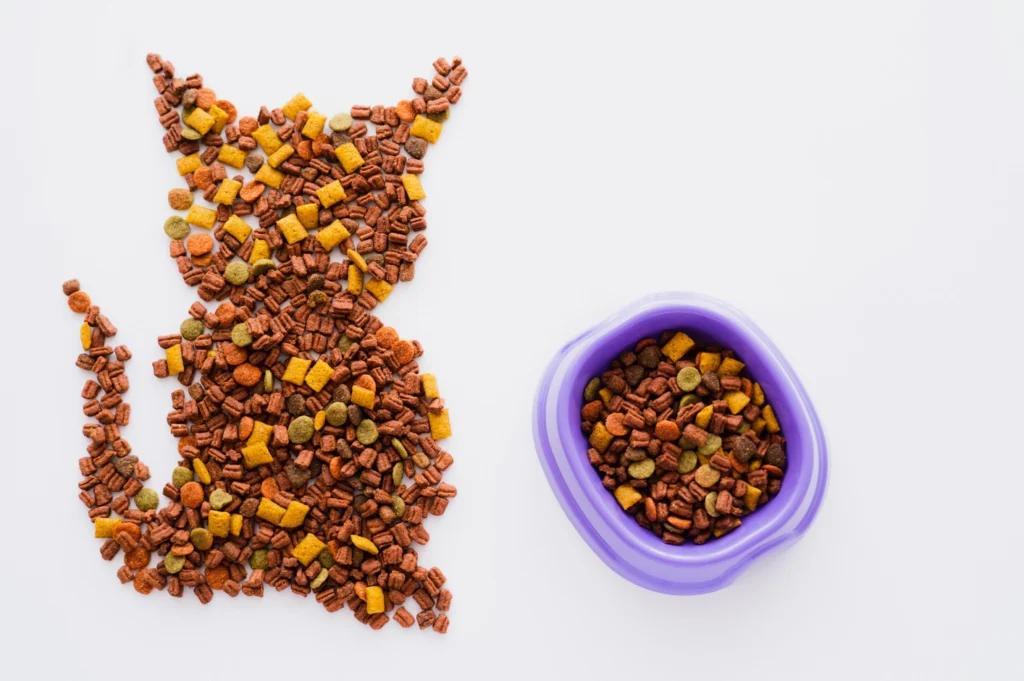
6. Popular Brands and 2025 Price Table
The table below shows average prices of 2 kg packages of frequently sold brands in the Turkish market (based on the fluctuating exchange rate in April 2025).
| Brand | Formula | Price (₺) | Main Plus | Main Minus |
| VetPro | Sterilised +10 | 690 | Low phosphorus | Single flavor |
| PetLine | Grain‑Free Chicken | 580 | High protein (38%) | Not small‑kibble |
| RoyalCat | Indoor Hairball | 740 | Fiber support | May contain corn |
| NaturePlus | Hypoallergenic Duck | 810 | Single protein | High price |
| HappyPaws | Kitten DHA+ | 620 | DHA & colostrum | Online only |
External Link (dofollow): FEDIAF Nutrition Guidelines 2025
7. Facts About Homemade Diets
Although home‑cooked recipes are popular, it’s hard to meet cat food standards:
- If the calcium–phosphorus balance is off, bone loss may occur.
- Taurine deficiency leads to heart failure.
- Without vitamin premixes, levels of vitamins A, D and B12 drop quickly.
Long‑term homemade diets are not recommended without a veterinary nutrition prescription.
8. Frequently Asked Questions
Q1: How healthy is it to use the same cat food brand throughout a cat’s life, and how often and by what method should I change brands?
A: Cats are more selective than dogs about taste, so sticking to one brand for a long time can cause poor appetite and lack of nutrient variety. Switching to a different formula in the same life‑stage category (kitten, adult, senior) every 6–8 months with a 7–10‑day gradual transition is the healthiest way. Start with 75% old food + 25% new food and increase the proportion of the new food every two days to minimize gastrointestinal stress.
Q2: Is grain‑free cat food truly more nutritious than standard formulas containing grains, or is it just a marketing claim?
A: “Grain‑free” products can improve digestive comfort in cats with sensitivities to corn or wheat proteins; however, the biological value and digestibility of animal protein are more critical. For healthy cats, balanced formulas that include grains can also provide an adequate amino acid profile. The 2024 FEDIAF guideline indicates that grain is not a mandatory allergen and the real focus should be on total starch level and protein bioavailability.
Q3: My cat doesn’t drink enough water; which type of cat food or extra techniques can increase water intake?
A: Chronically low water intake increases the risk of kidney failure. Wet foods with up to 70% moisture ease the load on the kidneys. Alternatively, grate low‑sodium bone broth (unsalted) frozen into ice cubes over dry food to boost flavor and moisture. Smart water fountains (moving water) can increase drinking by up to 20%.
Q4: Do cat foods labeled “hypoallergenic” really reduce allergy symptoms, and which clinical criteria should I look for?
A: Hypoallergenic foods usually contain a single animal protein or use hydrolyzed proteins with molecular weight <10 kDa. For clinically meaningful results, the formula should be supported with a low‑glycemic carbohydrate like pea starch instead of grains, and the trial should last at least 8 weeks. The phrases “Veterinary Exclusive” or “AFS hydrolyzed protein” on the label are signs of reliability.
Q5: How do I calculate the daily calorie restriction for my cat to lose weight, and how do I convert this into grams of cat food?
A: First determine your cat’s target weight (ideal body condition score 5/9). Then calculate daily energy needs with Target weight (kg) × 50 kcal. Convert to grams using the ME (kcal/g) value on the package. For example, if a 4 kg target cat needs 200 kcal/day and the food’s ME is 3.8 kcal/g, 200/3.8 ≈ 53 grams per day.
Q6: What is the shelf life of opened cat food, and how should I store it to keep it fresh?
A: Oxygen and light oxidize fatty acids, causing loss of flavor and nutrients. Ideally, opened dry food should be consumed within 4–6 weeks. Store the bag in an airtight container at 15–20 °C and away from direct sunlight. Silica gel packets provide extra moisture absorption. Once opened, wet foods should be used within 48 hours under refrigeration (4 °C).
Q7: Is it safe to buy discounted cat food nearing its expiration date, and how are nutrients affected?
A: With 1–2 months left to expiration, fat oxidation increases; vitamin E and omega‑3 levels may drop by 15–20%. If your cat has dermatological sensitivity or cardiovascular risk, choose a fresher batch. Still, if the package is vacuum‑sealed, intact, and odorless, short‑term consumption is possible.
Q8: What is the ideal time and protocol to switch from kitten to adult food?
A: Around the 7th month, growth slows and high‑calorie kitten formulas should give way to adult foods. A 7‑day protocol with 25% increments is recommended: Days 1–2 (75% old + 25% new), Days 3–4 (50% + 50%), Days 5–6 (25% + 75%), Day 7 fully new food. Sudden changes can cause diarrhea and gas.
Q9: For indoor, low‑activity cats, is a special cat food necessary to maintain energy balance?
A: “Indoor” foods typically have 10–15% fewer calories and extra dietary fiber than standard adult foods. This facilitates hairball passage while preventing weight gain. If you don’t prefer light adult or indoor hairball formulas, reduce the daily amount by 10% and plan play‑based calorie burning.
Q10: My cat frequently vomits hairballs; which ingredients help passage of hair and which cat foods should I look for?
A: Foods containing about 7% dietary fiber (beet pulp, psyllium) speed gastric transit. Medium‑chain fatty acids (MCFAs) provide slip to hair and prevent adherence to the intestinal wall. In hairball control products, using prebiotic fiber instead of malt extract offers a more long‑term solution.
Q11: After changing food, how long does it take for allergy symptoms (itching, redness) to subside, and when is veterinary intervention needed?
A: After switching to a hypoallergenic diet, clinical improvement is expected within 6–8 weeks because serum levels of offending antibodies decrease. However, if vomiting, severe weight loss, or itching requiring steroids persists, a veterinary dermatology evaluation is essential for possible secondary infection.
Q12: For cats diagnosed with kidney problems, what should I look for in the formula and what is the ideal phosphorus level?
A: In chronic kidney disease, choose prescription renal foods with phosphorus ≤ 0.4% and high‑quality protein (rich in taurine + leucine). Also, formulas supplemented with EPA/DHA and low sodium (Na < 0.3%) help preserve glomerular filtration rate.
Q13: For diabetic cats, which is better for glycemic control—dry or wet food?
A: A meta‑analysis published in 2024 shows that wet foods with ≥45% protein and <15% carbohydrates reduce postprandial glucose spikes by 35%. However, low‑carb “Diabetic Management” dry foods can be an acceptable alternative for cats that insist on dry food; insulin response should be monitored closely.
Q14: What is the effect of mixing dry food with canned food in daily meals on digestion or dental health?
A: Mixed feeding offers flavor variety and moisture advantage. The abrasive effect of dry kibble benefits dental health, while the high moisture of wet food supports kidney function. A balanced ratio can be planned as 60% dry + 40% wet.
Q15: Does moistening dry food with water or broth increase plaque formation, and when should it be avoided?
A: Moistening reduces particle hardness and therefore the mechanical cleaning effect on teeth; it isn’t recommended for cats with tartar issues. However, if kittens or seniors have chewing difficulties, moistening becomes a priority over dental benefits.
Q16: To what extent do prebiotic‑ and probiotic‑supplemented cat foods prevent diarrhea in cats on antibiotics?
A: Foods containing Enterococcus faecium NCIMB 10415 and MOS/FOS fibers reduce antibiotic‑associated diarrhea by around 40%. In clinical studies, probiotic‑supplemented formulas improved stool scores by 1 point during a 10‑day antibiotic course.
Q17: What is the mechanism by which taurine deficiency leads to heart disease, and what minimum value should I look for when choosing cat food?
A: Taurine regulates myocardial calcium flux and acts as an antioxidant. Deficiency causes dilated cardiomyopathy (DCM). FEDIAF requires at least 1500 mg/kg taurine in dry food and 2000 mg/kg in wet food.
Q18: I can’t find the phosphorus level on the label; why do some manufacturers hide this information and how can I choose safely?
A: Phosphorus labeling isn’t mandatory in the EU, though it’s often disclosed voluntarily. For healthy cats with low renal risk, a P value between 0.6–1% is acceptable. If not stated, you can request a Certificate of Analysis (COA) from customer service.
Q19: For obese cats, is it enough to use only light cat food, or is a combination of portion control and exercise more effective?
A: Light foods generally have an energy density of 3.0–3.2 kcal/g. However, clinical studies show that achieving a calorie deficit with 70% portion control and 30% exercise yields ideal weight loss in 12 weeks. A daily 15‑minute laser game or tunnel exercise increases metabolic rate.
Q20: Are joint‑support cat foods worth it for senior cats; what should the doses of glucosamine and chondroitin be?
A: About 60% of senior cats have osteoarthritis signs that are not evident on X‑ray. Senior formulas containing at least 400 mg/kg glucosamine sulfate and 250 mg/kg chondroitin sulfate can improve mobility by 15% after 3 months of regular use.
Q21: How exactly do protein and calorie requirements change in pregnant and lactating cats; which values should I look for on the label?
A: From the 3rd week of gestation, calorie needs increase by 25%, and protein requirement rises to 36%. Kitten foods enriched with DHA (0.2%) can be safely used during pregnancy. During lactation, calorie needs increase by up to 60%, so ad libitum feeding is appropriate.
Q22: How risky is it to eyeball the amount of food without a measuring cup, and is there a practical method?
A: Due to density differences, plastic measuring cups can cause ±20% gram errors. Simple kitchen scales offer 0.1 g precision. If you don’t have a scale, measure with a standard 200 ml glass once, weigh the content to determine grams, and use that as a reference.
Q23: What nutrient deficiencies can low‑priced cat foods cause in the long term, and which tests can reveal this?
A: Budget foods often use plant gluten as a protein source; digestibility drops below 75%. Long term, taurine and linoleic acid deficiencies can cause dermatological issues. In serum biochemistry, low BUN (blood urea nitrogen) may indicate poor protein quality.
Q24: Vomiting or diarrhea started during the transition to a new food; if extending the transition doesn’t help, which advanced tests are needed?
A: If problems persist despite a 14‑day transition, consider parasitic screening, the pancreatic lipase (fPL) test, and abdominal ultrasound. An elimination diet can be used if food intolerance is suspected.
Q25: Why is tracking the batch (lot) number critical when buying cat food, and how can I learn about recall announcements?
A: The batch number enables targeted recalls in cases of raw material errors or contamination. In Turkey, recall lists are published by the Ministry of Agriculture and Forestry and on manufacturers’ websites. The batch number is also needed to claim compensation from the manufacturer in packaging‑related issues.
9. Conclusion: Choose Smart, Live Healthy
The right cat food is part of the quartet: balanced ingredients + appropriate portion + clean water + regular veterinary checkups. The growing number of brands in 2025 can be confusing, but with label‑reading skills, choosing formulas suitable for age and health status, and reliable price comparisons, you can simplify the process.



